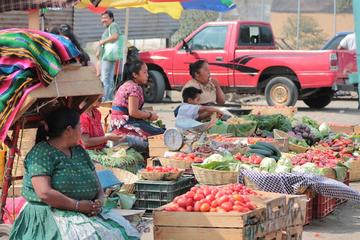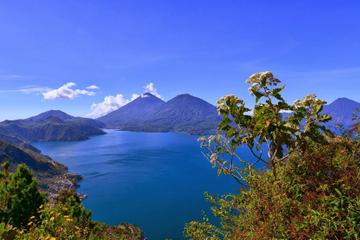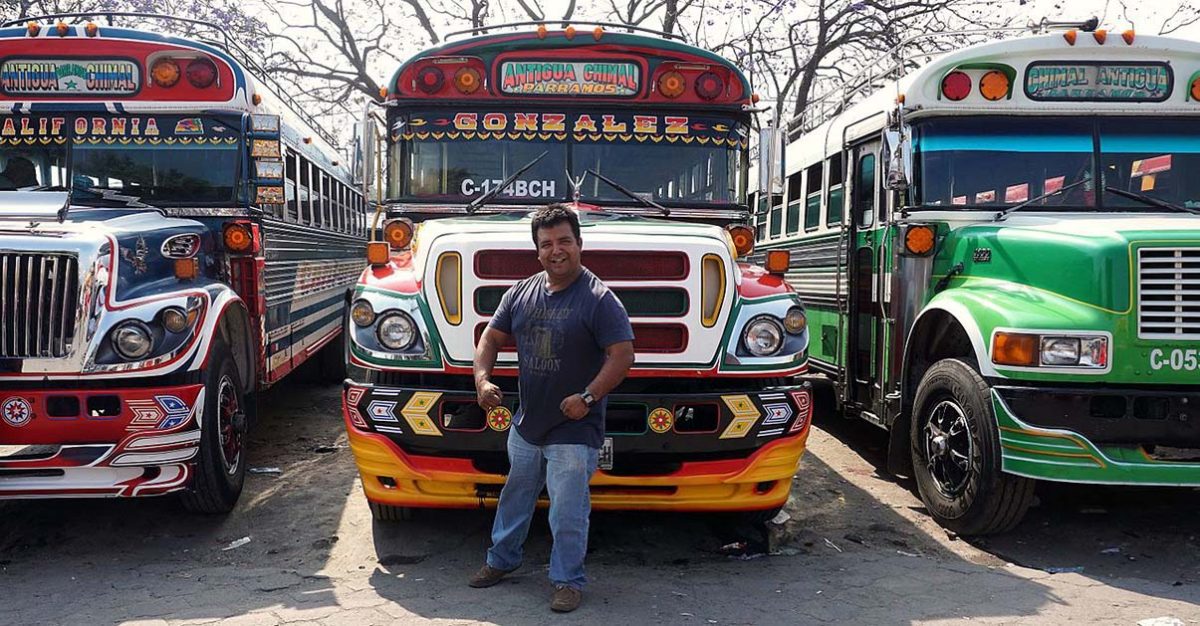
by Rick Neil
The first streaks of daylight brush the sky as I approach the bus station in Huehuetenango, Guatemala. My breath is visible in the dank morning air as I search for my bus among the worn-out Bluebird models strewn across the dusty lot. I locate my chariot near the back, the most beat-up warhorse of all. The destination is scrawled barely legible across the front: “Nebaj”.
Over the past week, I’ve traveled to popular Guatemalan destinations like Antigua and Chichicastenango in secure private minivans. Now, spurred on by tales of lush semi-tropical forests and vibrant Mayan culture, I’m about to venture into the country’s seldom visited northern highlands. Comfy shuttles are not an option here. The only modes of transport are segunda clase “chicken buses” that take animal as well as human passengers. The seven-hour trip ahead should be anything but boring.
I toss my bag up to a young guy on the roof, who fastens it among the others, securely I hope. Several local men squat amongst the baggage. Their situation doesn’t look too comfortable, but upon entering the bus I’m tempted to climb up and join them. The seats are bench-style, designed for two bodies but with three jammed into each. And those are the lucky ones. From front to back bodies stand pressed together like cold anchovies.
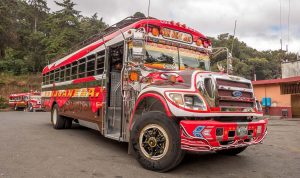 I shove my way to the rear where I hope it might be less congested, but no such luck. I’m surrounded by people who look to be Mayans or a mix of Latino and Mayan. The women have long raven hair, tawny complexions, and full Mayan lips. Many wear huipiles, handmade garments woven in multihued geometric patterns.
I shove my way to the rear where I hope it might be less congested, but no such luck. I’m surrounded by people who look to be Mayans or a mix of Latino and Mayan. The women have long raven hair, tawny complexions, and full Mayan lips. Many wear huipiles, handmade garments woven in multihued geometric patterns.
The men are not as colorfully attired. A few wear crisp, black suits but most look as if they’ve been wearing the same wrinkled garments for days. They have the lined faces and cracked, blackened hands of dirt farmers. I spot only one chicken, tucked quietly beneath the jacket of a sheepish-looking gent seated by the window. I’m kind of disappointed, until I notice three squealing baby pigs tied to the back of the rear seat.
As more people continue to squeeze onboard, I’m pushed even further back. An old man with sun-baked skin and a toothless grin leans into me, reeking of gin and chili peppers. Again I consider joining my backpack in the crow’s nest. In spite of the cramped conditions and early hour, the passengers are animated, chattering and laughing with typical Latino gusto. My limited Spanish only permits me to grasp smatterings of conversations, but I understand enough to realize that everyone is gossiping about friends and family. “My son wants to move to Guatemala City,” a stout, middle-aged man grumbles. “Who will help me on the farm?” “How can Lupe marry that worthless drunk?” a young Mayan woman with coal-black eyes asks. “She thinks she’ll change him but we’ll see.” Apparently, this bus is not just a means of transport, it’s a local forum.
I’m jolted from my musings by earsplitting Latino music pounding from a cassette our driver has plopped into the dashboard stereo. It’s way too early for this, I think, until I realize that this musica may be the only thing keeping our pilot awake.
As the The Gipsy Kings resonate throughout the bus the engine groans and then roars to life. The driver, who wears a torn, filthy t-shirt far too small to contain his massive belly, spits out the window and grinds the skeleton-head stick shift into gear. He makes the sign of the cross to a tiny image of Jesus as we lurch over mammoth potholes and onto the road in front of the station.
Within minutes the city lights fade as we ascend into brown, rocky hills toward lush, green mountains. In the muted light of daybreak I observe an old man in a white outfit leading a donkey up a dirt path. Naked children bathe in tubs outside modest adobe homes.
On a steep incline a camouflage green army truck races by. Bleary-eyed soldiers dressed in fatigues crouch in the back, shivering in the frosty morning air. They look no more than sixteen, clutching rifles nearly as big as they are.
When I check to see if my money belt is still with me, I realize that I no one has come to collect bus fare. I wonder if we pay when we get off, though that seems unlikely. My question is answered when a pimply, teenage boy clutching a wad of bills emerges from the wall of humanity in front of me. Somehow he manages to collect money from each passenger, make change, and inform the driver where each party wants to be dropped off. I lay out fourteen quetzals, or about two dollars, for the seven-hour trip, a tenth of what I paid for private shuttles.
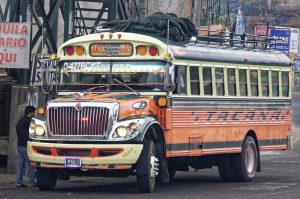 We never pass anything that resembles a bus stop. If someone wants to be picked up they stand by the roadside and gesture at the driver. Passengers are dropped off wherever they please. After the baggage guy has tossed down their luggage from the roof he signals with a loud BANG-BANG on the metal roof that it’s okay to move on.
We never pass anything that resembles a bus stop. If someone wants to be picked up they stand by the roadside and gesture at the driver. Passengers are dropped off wherever they please. After the baggage guy has tossed down their luggage from the roof he signals with a loud BANG-BANG on the metal roof that it’s okay to move on.
After a couple of hours we’re in the mountains. The bus whimpers up the increasingly windy, now unpaved road. It’s full daylight now but low clouds make for poor visibility. Through the mist I catch outlines of turquoise mountains, fertile valleys, and fields of corn. At the base of a cliff I spot an overturned bus just like the one I’m on. Flowers decorate nearby tombstones, a reminder that this journey is no magical mystery tour.
When we approach the first of several hairpin turns, a fourth crew member jumps off and runs forward to check for oncoming traffic. When he is satisfied that the road ahead is clear he indicates with a shrill whistle that it’s safe to continue. He then leaps back on while the bus is moving. Once, when a truck approaches around the bend ahead of us, we must inch slowly down the hill for several hundred feet till we reach a point wide enough for the vehicle to pass. I’m numb with fear the entire time, but my fellow passengers seem unruffled, as if they go through this all the time.
Just after we’ve negotiated a particularly sharp curve, we approach a wide clearing where the army pickup that passed us earlier is parked next to a larger military truck. A young soldier motions with his rifle for us to pull over, and then barks something at our driver who motions for us to disembark and wait outside.
What now? I wonder. I read that there had been problems with rebel guerillas but that the region was now stable. I wonder if the soldiers are on the lookout for banditos, or if they’re only disguised as soldiers and are actually banditos themselves. What if I’m held for ransom? I realize that no one back home knows I’m here. I have visions of myself as the subject of a CBC documentary about a Canadian who mysteriously vanished in the highlands of Guatemala.
A moustachioed hombre in fatigues emerges from the rear of the truck brandishing a long metal object that looks at first glance like a machine gun. My heart leaps into my throat, but as he approaches I can see that he is actually carrying a large canister. He enters the now empty bus and proceeds to spray the inside from front to back. After he finishes what I assume is a de-lousing we are told to re-board and within minutes we’re back on our way. For the next twenty minutes everyone is sneezing and coughing from the noxious fumes. I’m certain that whatever I’m inhaling is not at all healthy, but relieved that my name is less likely to pop up on the CBC news.
A voluptuous señora with a prominent beauty mark beams up at me. “We arrive very soon in Nebaj,” she explains in halting English, “is very lovely and good Mayan culture.”
“I hope so,” I tell her, “I’ll be glad to get off this bus.”
“This normal for me,” she chuckles, “I ride every week this bus for work.”
I nod, reflecting on my “chicken bus” odyssey. This ride hasn’t exactly been fun, but for the last several hours I’ve definitely been living “in the moment”. Part of the reason for my wanting to visit the secluded village of Nebaj was to seek out an authentic Mayan experience. To my surprise, I found exactly that on this dilapidated bus. As we approach the outskirts of Nebaj I recall the new age mantra: “It’s not the destination, it’s the journey.”
If You Go:
NEBAJ
Nebaj is the largest of three villages that make up the Ixil Triangle in Guatemala’s northern highlands, one of the smallest ethnic regions in Central America. Few tourists venture to this isolated area, though it offers spectacular scenery and captivating Maya culture. Local women wear blouses with multi-colored geometric patterns over bright crimson skirts, and decorate their hair with red and green pompons. Many sell gorgeous hand-woven wall hangings, crocheted handbags and thick woolen blouses directly from their homes.
Nebaj is only accessible by second-class bus from Huehuetenango (7 hrs.) Santa Cruz del Quiche (2.5 hrs.) or Sacapulas (1.5 hrs.). Reportedly, the road has recently been paved. Pack some Gravol.
HOTELS, RESTAURANTS and HOMESTAYS
For a small town well off the beaten track, Nebaj has a good selection of budget and mid-range accommodations priced from $20 to $40 for a clean basic double. All are within a few blocks of the main square, and many have internet access. It is also possible to arrange a homestay with a local family in Guatemala, or to bone up on your Espanol at a local Spanish school.
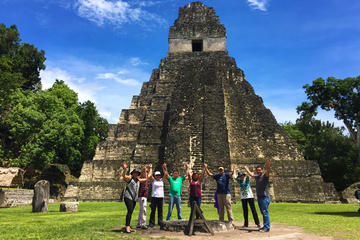
Tikal Maya Ruins Full Day Tour from Guatemala City
About the author:
Rick’s travel career began as a college student when he impulsively signed up for an international student exchange program and spent that summer working in Turkey. “Don’t go there!” the naysayers said, “it’s not safe!” Luckily, Rick ignored their advice and discovered that the outside world is a place of wonder worth exploring. Since then his wanderlust has taken him to Central and South America, England, Vietnam, Morocco, and China, where he spent an unforgettable year teaching English. Rick makes his home in East Vancouver, Canada, where he writes for various travel publications.
Guatemala chicken buses and driver photo by: Erik Albers / CC0



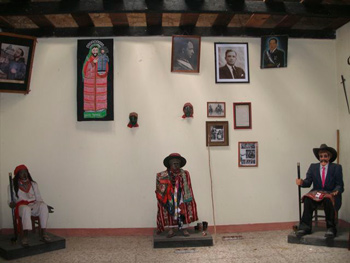
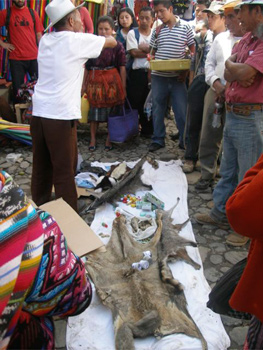 Stepping out of the bus at Chichicastenango on market day is like being hit right between the eyes. You are met by a loud seemingly chaotic atmosphere filled with unintelligible languages, the smell of burning incense and traditional herbs and a sea of bright colored clothing. The maze of temporary stalls through which you must pass in order to reach the tourist sites adds to your sensory overload.
Stepping out of the bus at Chichicastenango on market day is like being hit right between the eyes. You are met by a loud seemingly chaotic atmosphere filled with unintelligible languages, the smell of burning incense and traditional herbs and a sea of bright colored clothing. The maze of temporary stalls through which you must pass in order to reach the tourist sites adds to your sensory overload. Take your time looking around for the best deal because prices are cheaper further away from the center of town and you are heading toward the centre of town.
Take your time looking around for the best deal because prices are cheaper further away from the center of town and you are heading toward the centre of town.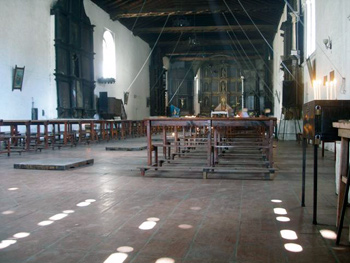 The dimly lit interior of the church is saturated with smoke from past Mayan offerings. Take care where you step because you might accidentally walk over the remnants of an offering of flowers, corn or even alcohol set on or near one of ten low concrete platforms running along the length of the center aisle. Multi-colored gobs of wax suggest that the candles were set in pre-arranged patterns on these once-smooth surfaced altars. Roughly finished planks cover the apse behind the “Catholic” altar. Three saintly statues are set on recesses in each of the side walls. After observing the mix of two religions I could almost imagine these statues saying to themselves of their Mayan co-tenants “If you can’t beat them, join them.”
The dimly lit interior of the church is saturated with smoke from past Mayan offerings. Take care where you step because you might accidentally walk over the remnants of an offering of flowers, corn or even alcohol set on or near one of ten low concrete platforms running along the length of the center aisle. Multi-colored gobs of wax suggest that the candles were set in pre-arranged patterns on these once-smooth surfaced altars. Roughly finished planks cover the apse behind the “Catholic” altar. Three saintly statues are set on recesses in each of the side walls. After observing the mix of two religions I could almost imagine these statues saying to themselves of their Mayan co-tenants “If you can’t beat them, join them.”
 You can also cross the plaza and visit the Calvary Chapel which is a scaled-down version of the Church of Saint Thomas. Inside there are only three low concrete slabs on which to place offerings. The apse features an intricately carved wooden altar and the side walls feature hand-painted murals.
You can also cross the plaza and visit the Calvary Chapel which is a scaled-down version of the Church of Saint Thomas. Inside there are only three low concrete slabs on which to place offerings. The apse features an intricately carved wooden altar and the side walls feature hand-painted murals.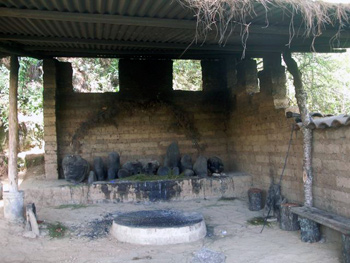 The owner of the museum proudly pointed out that both he and his forbearers were all shamans. After touring the museum, the owner invited us to visit the Mayan altar set on the hillside behind the museum. After a short, steep climb we arrived at a large stone approximately 6 by 12 square feet and 18 inches high set under an awning. Fourteen small stones and two crosses placed there by the Spanish were the only decorative features. At the center of the altar is a shallow depression approximately 4.5 feet in diameter that is still used for burnt offerings by Mayan Shamans. Some straw fibers were still visible on the altar surface, likely from a recent offering.
The owner of the museum proudly pointed out that both he and his forbearers were all shamans. After touring the museum, the owner invited us to visit the Mayan altar set on the hillside behind the museum. After a short, steep climb we arrived at a large stone approximately 6 by 12 square feet and 18 inches high set under an awning. Fourteen small stones and two crosses placed there by the Spanish were the only decorative features. At the center of the altar is a shallow depression approximately 4.5 feet in diameter that is still used for burnt offerings by Mayan Shamans. Some straw fibers were still visible on the altar surface, likely from a recent offering.
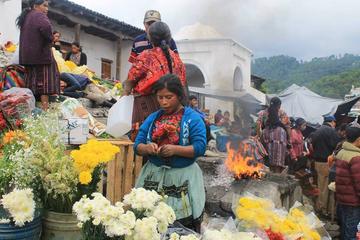

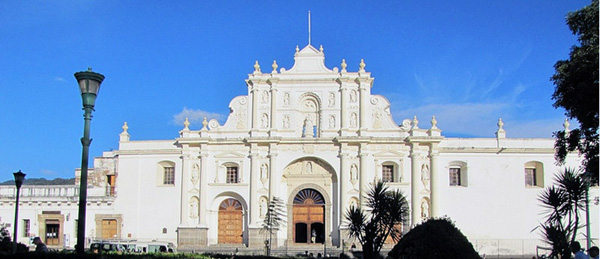
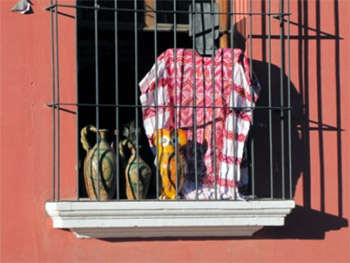 Nowadays, Antigua is a UNESCO World Heritage Site. What the mass exodus of 1773 left behind were around forty once-sturdy stone churches, beautiful cobblestone streets, and a vibrant culture not swallowed by the dirt and danger of today’s capital. Antigua’s streets are lined with pastel storefronts. Its parks are highly trafficked with pedestrians and thick with greenery. Its population is a fantastic mix of indigenous Maya, locals, international volunteers, long-time expats, and travelers who just can’t bring themselves to leave.
Nowadays, Antigua is a UNESCO World Heritage Site. What the mass exodus of 1773 left behind were around forty once-sturdy stone churches, beautiful cobblestone streets, and a vibrant culture not swallowed by the dirt and danger of today’s capital. Antigua’s streets are lined with pastel storefronts. Its parks are highly trafficked with pedestrians and thick with greenery. Its population is a fantastic mix of indigenous Maya, locals, international volunteers, long-time expats, and travelers who just can’t bring themselves to leave.
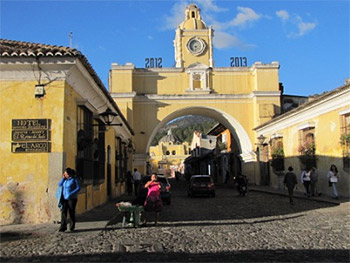 From Parque Central, its shade trees and centerpiece Mermaids’ Fountain, things spread in all directions. The ruins, churches, markets, and restaurant-café-bars are too plentiful to take in in one day of exploration, but rather it’s best to choose a healthy mix of sites. For me, there are certain highlights I like to use to create the initial wow for visiting relatives:
From Parque Central, its shade trees and centerpiece Mermaids’ Fountain, things spread in all directions. The ruins, churches, markets, and restaurant-café-bars are too plentiful to take in in one day of exploration, but rather it’s best to choose a healthy mix of sites. For me, there are certain highlights I like to use to create the initial wow for visiting relatives: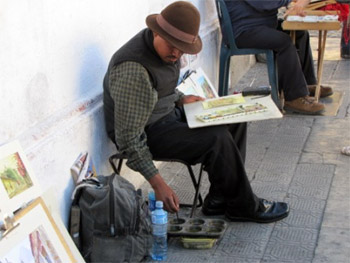 ♦ Ruins: Like churches, ruins sightings occur here on a block-by-block basis. For the most remarkably sprawling specimen, La Recolección Architectural Complex, head to the far west edge of town, beyond the market and “bus station” (a parking lot with a collection of remodeled US school buses, aka chicken buses, which are a sight in and of themselves). La Recolección is a former monastery now surround by parkland.
♦ Ruins: Like churches, ruins sightings occur here on a block-by-block basis. For the most remarkably sprawling specimen, La Recolección Architectural Complex, head to the far west edge of town, beyond the market and “bus station” (a parking lot with a collection of remodeled US school buses, aka chicken buses, which are a sight in and of themselves). La Recolección is a former monastery now surround by parkland.